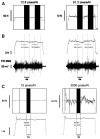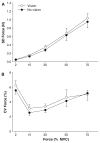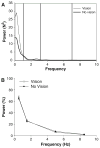Removal of visual feedback alters muscle activity and reduces force variability during constant isometric contractions
- PMID: 19544059
- PMCID: PMC3631578
- DOI: 10.1007/s00221-009-1883-5
Removal of visual feedback alters muscle activity and reduces force variability during constant isometric contractions
Abstract
The purpose of this study was to compare force accuracy, force variability and muscle activity during constant isometric contractions at different force levels with and without visual feedback and at different feedback gains. In experiment 1, subjects were instructed to accurately match the target force at 2, 15, 30, 50, and 70% of their maximal isometric force with abduction of the index finger and maintain their force even in the absence of visual feedback. Each trial lasted 22 s and visual feedback was removed from 8-12 to 16-20 s. Each subject performed 6 trials at each target force, half with visual gain of 51.2 pixels/N and the rest with a visual gain of 12.8 pixels/N. Force error was calculated as the root mean square error of the force trace from the target line. Force variability was quantified as the standard deviation and coefficient of variation (CVF) of the force trace. The EMG activity of the agonist (first dorsal interosseus; FDI) was measured with bipolar surface electrodes placed distal to the innervation zone. Independent of visual gain and force level, subjects exhibited lower force error with the visual feedback condition (2.53 +/- 2.95 vs. 2.71 +/- 2.97 N; P < 0.01); whereas, force variability was lower when visual feedback was removed (CVF: 4.06 +/- 3.11 vs. 4.47 +/- 3.14, P < 0.01). The EMG activity of the FDI muscle was higher during the visual feedback condition and this difference increased especially at higher force levels (70%: 370 +/- 149 vs. 350 +/- 143 microV, P < 0.01). Experiment 2 examined whether the findings of experiment 1 were driven by the higher force levels and proximity in the gain of visual feedback. Subjects performed constant isometric contractions with the abduction of the index finger at an absolute force of 2 N, with two distinct feedback gains of 15 and 3,000 pixels/N. In agreement with the findings of experiment 1, subjects exhibited lower force error in the presence of visual feedback especially when the feedback gain was high (0.057 +/- 0.03 vs. 0.095 +/- 0.05 N). However, force variability was not affected by the vastly distinct feedback gains at this force, which supported and extended the findings from experiment 1. Our findings demonstrate that although removal of visual feedback amplifies force error, it can reduce force variability during constant isometric contractions due to an altered activation of the primary agonist muscle most likely at moderate force levels in young adults.
Figures








References
-
- Brown P. Cortical drives to human muscle: the Piper and related rhythms. Prog Neurobiol. 2000;60:97–108. - PubMed
-
- Carlton LG. Visual processing time and the control of movement. In: Proteau L, Elliott D, editors. Vision and motor control. Elsevier; Amsterdam: 1992. pp. 3–31.
-
- Chao EYS, An KN, Cooney WP, Linschied RL. A basic research study. World Scientific Publishing; Teaneack, NJ: 1989. Biomechanics of the hand.
-
- Christou EA. Visual feedback attenuates force fluctuations induced by a stressor. Med Sci Sports Exerc. 2005;37:2126–2133. - PubMed
Publication types
MeSH terms
Grants and funding
LinkOut - more resources
Full Text Sources

